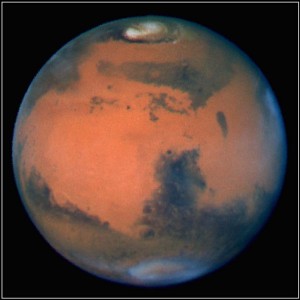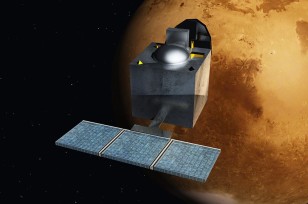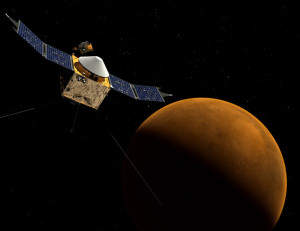
The planet Mars in late spring as imaged by the Hubble Space Telescope (NASA/JPL/California Institute of Technology)
Two unmanned spacecraft headed to Mars, one launched by the United States and the other by India, will soon reach the Red Planet within days of each other.
NASA’s Mars Atmosphere and Volatile Evolution (MAVEN) probe, launched November 18 is set for insertion into Mars orbit (MOI) on Sunday, September 21. India’s first interplanetary spacecraft, Mars Orbiter Mission (MOM), also known as Mangalyan, launched November 5 will be put into orbit around Mars on Wednesday, September 24.
MAVEN will study the specific processes that led to Mars losing much of its atmosphere about 3.5 billion years ago, something that could provide scientists with new insight about the evolution of the Red Planet as well as help solve the mystery of what happened to its water and carbon dioxide.
Some scientists say that billions of years ago, Mars had a rich atmosphere and was a warm and wet world. Others have speculated that the planet may have also had the right conditions to support microbial life.
University of Michigan Professor Stephen Bougher, who is also an investigator with the MAVEN team, told us that that it’s possible that the Martian H2O could have gone underground or was simple lost to space.
Among the immediate goals of the MAVEN mission, according to Bougher, is to find out how Mars’s upper atmosphere is connected to the solar wind that blows past the planet and how it strips away that upper atmosphere.
It’s possible that at some time during the early history of Mars the sun may have been much more active than today, producing a much more powerful solar wind that could have swept away Mars’ formerly lush atmosphere away like a broom sweeps dust and dirt.
Once scientists get answers to those present day questions, Bougher said the MAVEN team could run their computer models backwards in time to calculate what might have happened to Mars’s climate billions of years ago.

Artist rendering of India’s Mars Orbital Mission spacecraft nearing the Red Planet. (Nesnad via Wikimedia Commons)
Data sent back to Earth from the MAVEN spacecraft could also help scientists gain a greater understanding of climate change on the planet and learn more of the history of planetary habitability.
The Indian Space Research Organization’s (ISRO) MOM satellite will orbit Mars for about a year, exploring the Martian surface and atmosphere.
Although not directly connected with ISRO’s mission, Bougher said that India’s spacecraft won’t get as close to the planet as MAVEN.
MOM also has a methane detection and measurement instrument onboard that will look for signs of the gas in the Martian atmosphere.
The detection of methane on Mars is considered by some to be controversial, especially since most methane here on Earth is produced biologically (such as from cow flatulence). But, some (less than 1%) of our methane has been produced by non-biological methods.

A lab demonstration of the measurement chamber inside the Curiosity’s Tunable Laser Spectrometer, an instrument that found no sign of methane on the Red Planet in 2013. (NASA/JPL-Caltech)
While some previous Earth based observations indicated the presence of methane on Mars, a year ago NASA delivered disappointing news that “after extensive tests” its Curiosity Rover could not find any sign of the gas on the Red Planet.
Along with its scientific goals of studying the Red Planet, ISRO has said that one of MOM’s other main objectives is to allow the Indian space program to develop the technologies required to design, plan, manage and operate an interplanetary mission.
You can listen to the Science World radio interview with Professor Stephen Bougher either through the player below or check out the entire show at the times and places listed in the right side column.






















Why does the USA continue to spend money on such ridicules things? Our country is already bankrupt. Cant we find USEFULL things to spend our money on here on our planet.